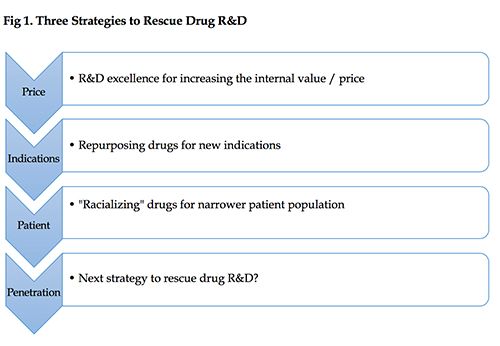A Formula for Rescuing Drug R&D
Jianan Huang discusses how the drug revenue formula is being used to guide R&D "rescue strategies".
Efforts to rescue drug R&D are moving from academic research to real-world practice. Some specific strategies, like drug repurposing, have been widely examined.[1] However, the real-world practice of many other related technologies are still not systematically reported by existing research.
Generally, these endeavors to rescue drug R&D can be summarized into three strategies:
(1) Firstly, to avoid a serious failure, a risky drug candidate will be transferred to academic center for R&D excellence.
(2) If the R&D problem cannot be overcome, the drug candidate will be repurposed for a new indications.[2],[3] Dimebon, a drug for Alzheimer’s disease, is a typical exmale of this.[4] Another notable case is Celgene’s Thalomid.
(3) If the drug repurposing still does not work, drug “racializing”, re-identifies a drug’s patients by race, may be employed that.[5] This strategy owes its success to human genomics technology, developed 20 years ago but not been used in drug R&D until recently.[6]
In real-world practice, looking business model innovation, we can observe three strategies to rescue drug R&D, aimed at changing internal value (price), indication, and patient population, respectively:
(1) R&D excellence aims to increase the internal value (price) of drugs. For example, Lilly set up Chorus in 2002, which is an operationally independent clinical development organization to rescue prior efforts if they fail to add to previous successes.[7]
(2) Drug repurposing aims to change the indications of drugs. Some big pharma companies already have their own units for this strategy, such as Pfizer’s Indications Discovery Unit, established in 2007.
(3) Drug “racializing” aims to narrow patient populations. Two real-world examples are Denovo Biopharma and Roivant Sciences (especially its Intepirdine product).
All of the above can be linked to one specific factor in the revenue formula of a drug:

According to the revenue formula of a drug, penetration rate is the only factor not covered by existing strategies to rescue drug R&D. The figure below shows a strategy that may affect penetration rate.

The evolution of strategies to rescue drug R&D reflects scientific advancement, but also indicates that scientists lack more effective ideas on increasing drug revenue:
- R&D excellence increases the factor (internal value, or price), hence the revenue may be increased.
- (2) Drug repurposing changes the factor (indication) and multiple indications may not add revenue but cannibalize the prior indication. For instance, the second indication would usually undercut the pricing opportunity for the first indication, hence a drug’s total revenue would not increase after a second indication is employed.
- Drug “racializing” decreases the factor (patient populations). Accordingly, the risk component is minimized but the revenue declines.
Compared to the first stage (R&D excellence), the second (drug repurposing) or third stage (drug “racializing”) usually has little benefit to drug revenue. Furthermore, every strategy is limited to improving one specific factor of the revenue formula. Consequently, breakthrough pathways are urgently needed in drug rescue, such as innovation in lifecycle management and portfolio management.
The revenue formula can guide drug rescue strategy; hopefully, health economics and outcome research can lead to further developments.
Jianan Huang, College of Pharmaceutical Sciences, Zhejiang University, Hangzhou, China.
References
[1] Naylor, S. and Schonfeld, JM. (2015) Therapeutic Drug Repurposing, Repositioning and Rescue Part II. Drug Discov. World, Spring Edition. 57-72.
[2] Pan, P., Munir, P., & Nasir, M. (2018). New Uses for Old Drugs. BMJ-Brit. Med. J., 2018; 361: k2701
[3] Sachs, R. E., Ginsburg, P. B., & Goldman, D. P. (2017). Encouraging New Uses for Old Drugs. JAMA – J. Am. Med. Asso. 2017; 318(24): 2421-2422.
[4] Burns, A., & Jacoby, R. (2008). Dimebon in Alzheimer’s Disease: Old Drug for New Indication. The Lancet, 372.9634, 179-180.
[5] Zissimopoulos JM, Barthold D, Brinton RD, Joyce G. (2017) Sex and Race Differences in the Association between Statin Use and the Incidence of Alzheimer Disease. JAMA Neurol. 74(2): 225-232.
[6] Lee, S. S. (2011). Racializing Drug Design: Implications of Pharmacogenomics for Health Disparities. Am. J. Public Health, 95(12), 2133-2138.
[7] Owens, P. K., Raddad, E., et al. (2014). A Decade of Innovation in Pharmaceutical R&D: The Chorus Model. Nat. Rev. Drug Discov., 14(1), 17-28.
Addressing Disparities in Psoriasis Trials: Takeda's Strategies for Inclusivity in Clinical Research
April 14th 2025LaShell Robinson, Head of Global Feasibility and Trial Equity at Takeda, speaks about the company's strategies to engage patients in underrepresented populations in its phase III psoriasis trials.
The Misinformation Maze: Navigating Public Health in the Digital Age
March 11th 2025Jennifer Butler, chief commercial officer of Pleio, discusses misinformation's threat to public health, where patients are turning for trustworthy health information, the industry's pivot to peer-to-patient strategies to educate patients, and more.

.png&w=3840&q=75)

.png&w=3840&q=75)



.png&w=3840&q=75)



.png&w=3840&q=75)









